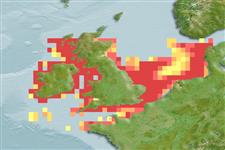Environment: milieu / climate zone / depth range / distribution range
Ecologia
marino demersale; distribuzione batimetrica 25 - 80 m (Ref. 130215). Temperate; 58°N - 48°N, 11°W - 9°E
Northeast Atlantic: all coasts of the British Isles and English Channel to northern Biscay.
Size / Peso / Age
Maturity: Lm ? range ? - ? cm
Max length : 35.0 cm SL maschio/sesso non determinato; (Ref. 4674)
Short description
Morfologia | Morfometria
Dark spot on each side of the snout absent (Ref. 35388).
Inhabits inshore and offshore, although only juveniles appear to occur close inshore. Feeds initially on zooplankton, but for lengths greater than 10 to 15 cm small fish, such as clupeids and ammodytids dominate the diet (Ref. 4674). Spawns in winter and has a more southern distribution (Ref. 35388).
Reay, P.J., 1986. Ammodytidae. p. 945-950. In P.J.P. Whitehead, M.-L. Bauchot, J.-C. Hureau, J. Nielsen and E. Tortonese (eds.) Fishes of the north-eastern Atlantic and the Mediterranean. UNESCO, Paris. Vol. 2. (Ref. 4674)
IUCN Red List Status (Ref. 130435)
Threat to humans
Harmless
Human uses
Informazioni ulteriori
BibliografiaAcquacolturaProfilo di acquacolturaVarietàGeneticaElectrophoresesEreditarietàMalattieElaborazioneNutrientsMass conversion
Strumenti
Special reports
Download XML
Fonti Internet
Estimates based on models
Preferred temperature (Ref.
123201): 9.2 - 12.3, mean 10.8 °C (based on 144 cells).
Phylogenetic diversity index (Ref.
82804): PD
50 = 0.7500 [Uniqueness, from 0.5 = low to 2.0 = high].
Bayesian length-weight: a=0.00316 (0.00164 - 0.00611), b=3.06 (2.89 - 3.23), in cm total length, based on LWR estimates for this species & (Sub)family-body (Ref.
93245).
Trophic level (Ref.
69278): 4.4 ±0.77 se; based on food items.
Resilienza (Ref.
120179): Medio, tempo minimo di raddoppiamento della popolazione 1.4 - 4.4 anni (Preliminary K or Fecundity.).
Fishing Vulnerability (Ref.
59153): Low to moderate vulnerability (33 of 100).
